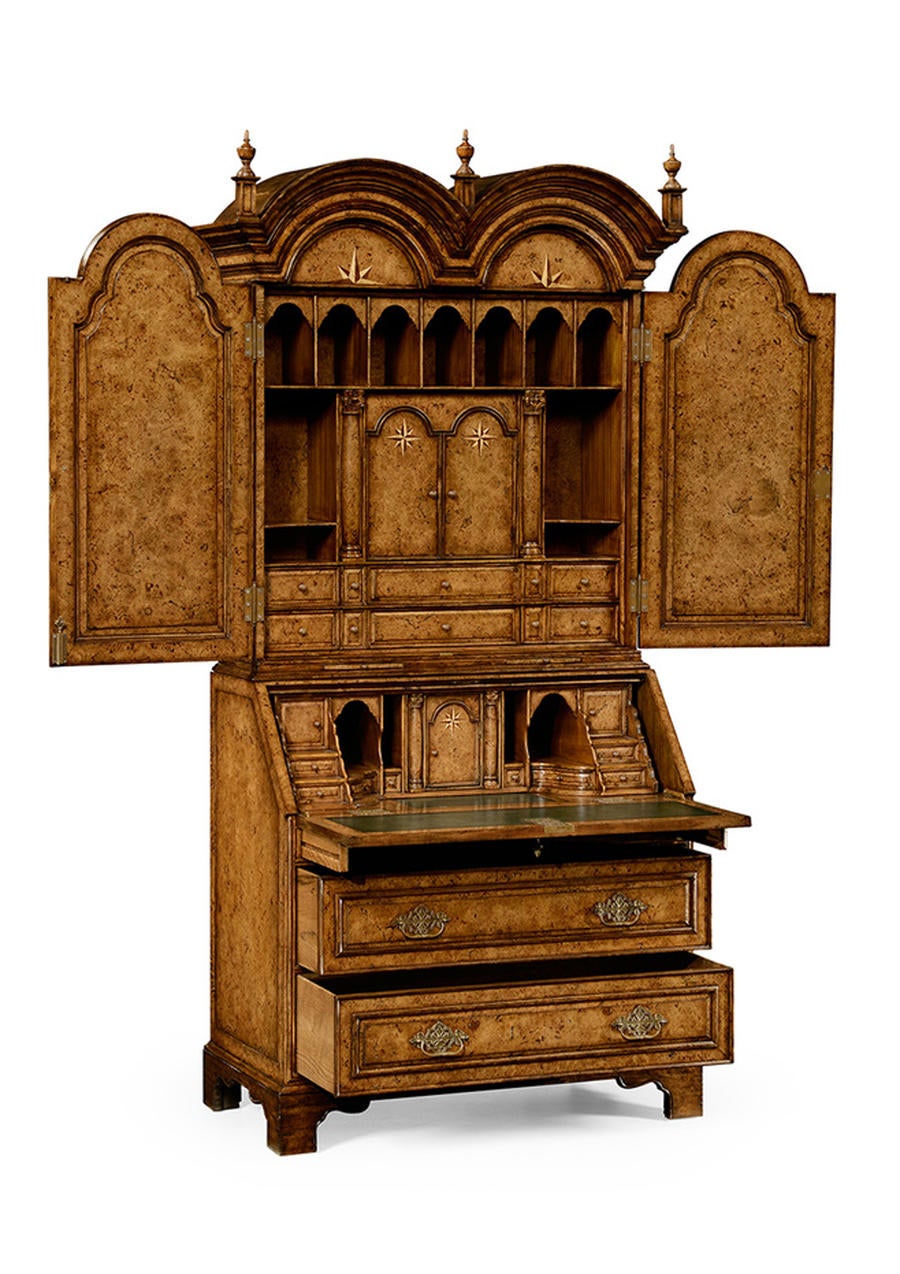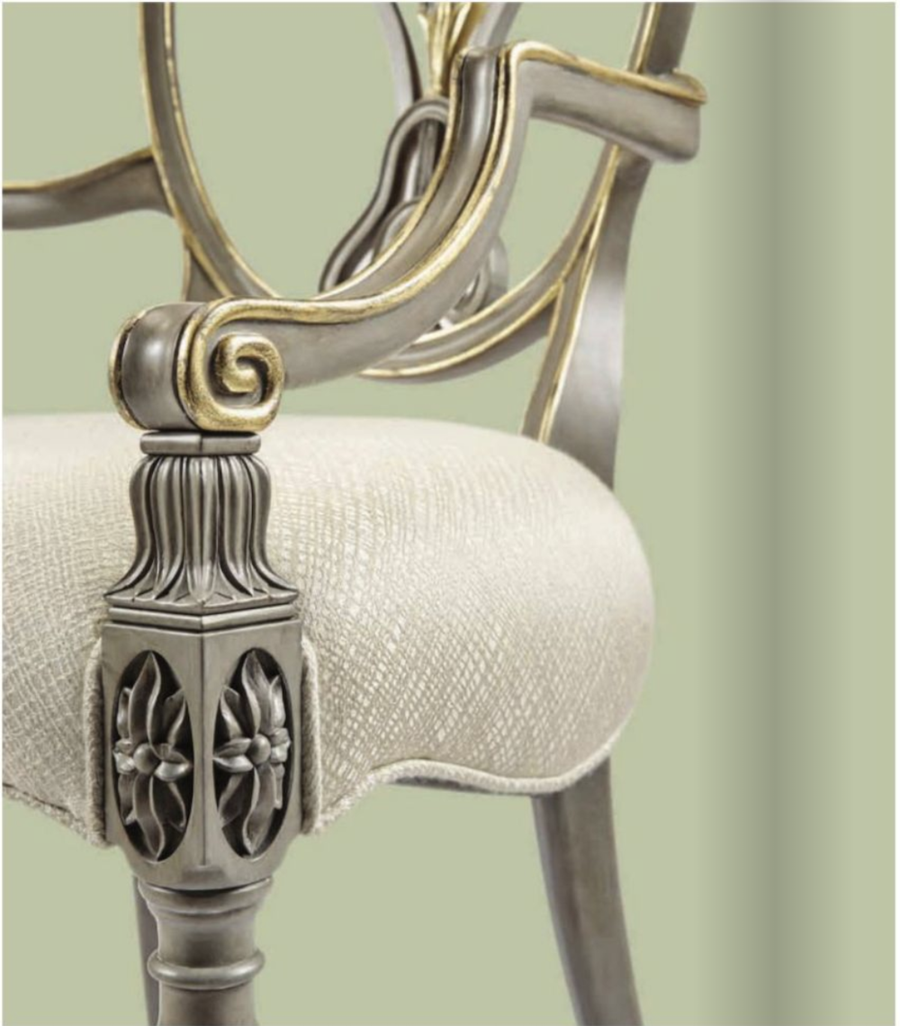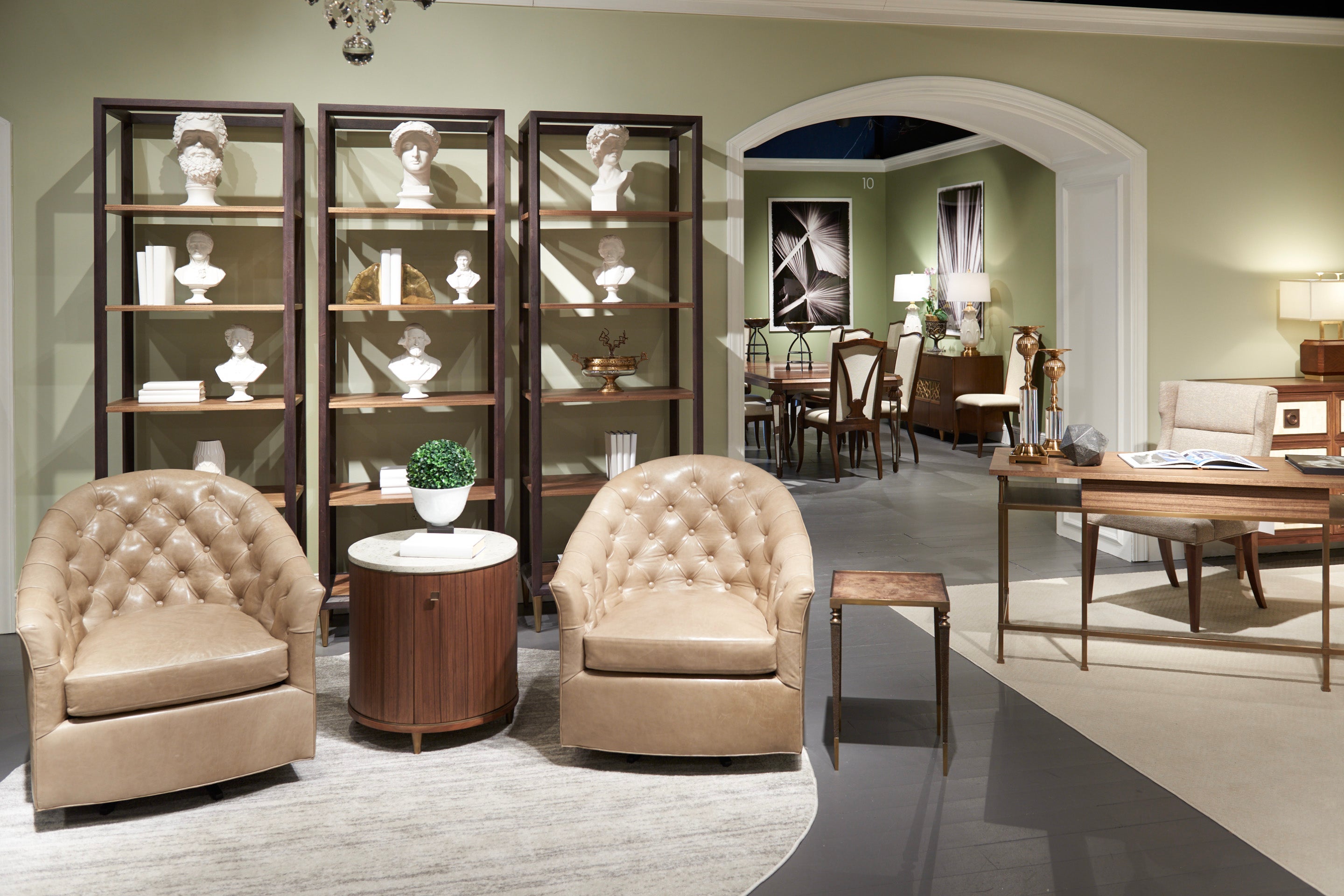I’ve been visiting the Jonathan Charles showroom at High Point for years, and had gotten used to a certain experience. Its winding footprint—a labyrinthine 22,000 square feet—unveiled a deep range of ornate pieces showcasing the brand’s mastery of complex inlay work, ornate carvings and hand-rubbed finishes. Antique reproductions, like a Queen Anne secretary with hidden compartments, mingled with trompe l’oeil marquetry, while William Yeoward’s collection evoked a charmed English country home. The end of the visit often culminated at the brand’s own Irish pub, complete with dark paneling and live music. In a nutshell: Tradition and technique were front and center.
At Fall Market last year, I stepped into the showroom and was shocked by what I saw. The brand was still highlighting its technical prowess, but gone was the trompe l’oeil. Instead, 11 new collections were on display, some surprisingly sleek and modern. And though I didn’t realize just how drastic the change was at the time, the number of pieces on the showroom floor was markedly decreased. In place of the pub, a cafe and gin bar was white and bright.
High Point brands don’t usually turn themselves completely upside down over the course of six months. Unsurprisingly, the radical changes on the front end were mirrored by big changes behind the curtain at Jonathan Charles.
The company, founded by English furniture maker Jonathan Sowter in 2004, built its early reputation making antique reproductions, then expanded into rustic and op-art lines over the past decade. In 2018, Chinese conglomerate Markor International Home Furnishings—which also owns A.R.T. Furniture, Caracole, and Rowe Furniture in the U.S. market—snapped up the company and last year added to the brand’s leadership team. Former Fine Furniture Design president Eric Graham joined the company as president of Jonathan Charles Designs (a subsidiary of Jonathan Charles Fine Furniture); while former Baker and Christopher Guy exec James Nauyok was tapped as its new creative director. The pair have wasted no time in reshaping the brand’s offerings—slashing more than 5,000 SKUs in addition to launching new pieces and transforming the marketing strategy. (Two additional collections will launch at Market this spring.) I sat down with them to find out how you make a brand modern while staying true to its roots, why they cut their selection by more than half, and what lies ahead.
The presentation of the Jonathan Charles brand at this market is dramatically different than past iterations. What’s changed?
James Nauyok: When we were hired in January 2019, the goal was to make Jonathan Charles a lifestyle brand. But we didn’t have any upholstery or beds—and lifestyle is really based on the bedroom, dining room and living room, so that was the initial challenge. We were a collection of items, not a lifestyle collection. So where we’re going now gives us a stronger platform to grow because we’re hitting all the notes.
I’ve never worked for a company like this, where it’s all about targeting where we need to go and how fast we need to get there. We have three teams of people working together—our factory in Vietnam, our partners in China, and our very small U.S. office—and we have 11 new collections launching here at once, which is a tremendous feat. But what’s even more amazing is that we kept the DNA of the company while coming into modern [design].
Keeping the DNA but making it modern—how do you do that?
Nauyok: Our goal is to have something that speaks to many customers, because America is so big: Do we have things that speak to the coast? Do we have things that speak to an urban market? The American lifestyle is a casual lifestyle. What’s happening here, and not anywhere else in the world, is casual luxury. The strategy has been to enhance and add to existing collections, as well as create brand-new collections, incorporating [traditional] techniques into a modern perspective.
Most people don’t realize that things that look simple are actually the hardest to make. A clean line of stainless steel and wood is tremendously difficult, because both materials react to temperature and humidity differently—but it’s also the only way to get a clean metallic line that’s not faux-painted or whatever. [Another] hurdle [has been] organizing the collections so that they make sense and create a journey through [our] three different buildings. So the top floor is all modern, and if you go into our three traditional rooms, each collection is distinct and has different wood species and materials, as well as a perspective for who lives in those rooms. We’ve created marketing materials to support that and focus on what we do best, which is the details.
What does that mean for the company’s catalog of products? Did you have to edit down the line?
Nauyok: We’ll never [fully] get out of traditional, because once you do that, your factory loses the skill set [those pieces require]. It’s always important to have that challenge. What you’re seeing in [the new] Buckingham collection is traditional pieces with a different finish—it changed everything. When you look at the arc of traditional [design], things ebb and they come back in a different way. What we’re showing this Market is a look at traditional in a different way. The bones are the same. We’ve only ever shown those shell-back chairs in a dark mahogany; now all of a sudden it’s like, Oh, my God, they’re pretty. They’re feminine. They can work in a completely different project, or for a designer that will look at us differently.
Eric Graham: There is a lot of history in these [new] pieces, but the history may be 1950 or 1920—it doesn’t always have to be 1700s to 1800s. What’s interesting to me is that, in most rooms, there’s a touch of history—something that grounds [the space] in some way. Even in spaces with great contemporary, ultramodern style, there’s something that’s got provenance and authenticity.
Nauyok: We did cut quite a bit too. I think that editing is constant—and you always have to do it. Here, we started [in January 2019] with 7,000 SKUs and we’re down to around 2,500 now. And our business has increased! It’s really not about having more pieces, it’s having the right pieces. People will come to us because we can make things that no one else can, like that secretary that’s been on the line forever—that’s the key.

I look for all the hidden drawers in that secretary every single time I’m here and I can never find the last one.
Nauyok: Those are things you’re never going to move away from. Are you ever going to sell thousands of them? No. But you know they’re part of who we are.
How do you go from 7,000 to 2,500 SKUs? That’s a pretty drastic cut. Is that a decision you make while looking at a spreadsheet, or more of an emotional choice?
Nauyok: It’s both. You have to look at it and ask, What makes sense? Let’s say the dining table doesn’t sell but the chairs do. You have a choice. You can either do a new dining table or think of something completely new. And let’s be honest: There’s a life cycle for everything. Let’s say you have a great collection, but in five years the coffee table is seeing declining sales. You’ve always got to be bringing in other items to respond to how people live differently now than they did five years ago. You know, is it a round cocktail table or a rectangular cocktail table? Frankly, designers help us [with that], because they’re telling us what their clients need. We’re not telling them, “Here’s the chair, buy it.”
What does this change say about where the brand is going?
Graham: One of the things that happens to a company if they’re not evolving, they get pigeonholed—they get held in a channel and associated with something, the look or aesthetic that people reliably turn to them for. That becomes a niche that you can’t break out of. But when you have a hugely talented factory and this ability to translate any design or direction, and they do it with such intensity of craftsmanship and material selection, you’re doing a disservice to their ability by not broadening the scope of how people view you. We have 22,000 square feet of showroom space here in High Point. You don’t need 22,000 square feet to show one look.
I’ve heard from some designers who said, “We really haven’t bought from you guys in a while, because we didn’t see it as fitting needs of customers as they were moving. But we always knew we could come back and get traditional from you.” That’s not really a good statement. That’s not a statement of longevity. It’s easy to condense [the footprint of the antique reproductions in the line], because today, everybody’s willing to shop out of catalogs or go online. Even the buyers that come to market, we can use 600 square feet to share the message that used to be told in 20,000.


For all those people who maybe have pigeonholed the brand, how do you break out of that?
Graham: You shock them. You do this. It’s almost like this showroom is 22,000 square feet of elevator pitch. If you have to say it with “if,” “and” or “but,” start over. Get it down to a message that’s condensed, concise, easy to understand. But you shouldn’t do something [just] because you can—that’s a bright shiny object. Then you’re in categories that you shouldn’t be in—especially if it doesn’t showcase something special about the brand. You end up really distracting from your message if you’re doing it just because you can.
There had been talk of leaving this showroom, and you’ve decided to stay. What contributed to that decision?
Graham: That’s easy: a contract. We have a lease here. When moving into a new showroom didn’t come to fruition and we ended up going backwards—or what [initially] felt like backwards—it really wasn’t a bad thing. Because [people] would have expected the new setting and maybe not given [our evolution] the same weight or value as [we accomplished] by staying here.
Because it was a familiar space with a completely new look?
Graham: Now they see it and go, “Whoa. All right, so they were willing and ready to really change things, not just the space.” I also believe it makes a good statement if the space doesn’t make your brand.
When you talked about being a lifestyle brand, how does vision here fit in with the bigger Markor strategy and portfolio?
Nauyok: Markor acquired Jonathan Charles because we have capabilities that can’t be done anywhere else. We have our own foundry, we make our own hinges—we do things that no one else can do. And mind you, Markor has 11 other factories. But the idea is that all four brands are individual but they all complement each other. We’re very careful that we don’t bleed into each other’s strength. I’ve managed a lot of fashion brands, and it’s easy to have an idea that works for one that you put everywhere. Then all of a sudden, they all look the same. Markor is very careful that we’re just four brands in the U.S. Markor has more than a dozen brands in China and they’re each distinctly different. So it’s very strategic as far as where [the company] is going.
Where are the opportunities for growth?
Graham: I think we’re already living in the next opportunities. For one, selling to retailers. It’s not that we don’t sell to retailers, but we don’t sell to them enough. We don’t speak their language when we don’t have a full collection that allows them to floor parts of a collection and let the catalog do the work. The catalog now does the work.
On the design side, a group of 35 designers came through yesterday, and 29 had never done business with us. They didn’t know who we were. To me, that’s an opportunity. To think that [you’ve] talked to everybody after 15 years—that you’ve done all you can, that you have no more growth? We’ve just scratched the surface with the accounts we have.
Nauyok: I think this is a 180 from where we were just six months ago. Is our job done now? No. I think there’s still a lot of work to do, as well as a lot of opportunities. We’re spending a lot of time talking with customers. What do they like, what are the things that they wish we had? I’ve been in the fashion industry, I’ve been in the furniture industry. This industry is unique in that everybody wants everyone to succeed. It really feels like you’re partners—with your design centers, your designers, your retailers and your end consumers. Again, we want to know what the needs are. How can we be problem solvers versus just selling items?
When I was here last market, there was a plan to quickly introduce dozens of Jonathan Charles stores across China. Is that still part of the strategy?
Nauyok: That’s still happening. What we’re finding is that even though the world is a very large place, what you don’t want to do is necessarily make products specifically just for one market. However, certain markets will veer this direction or that direction. For us, High Point is not just an American marketplace. We have global buyers who are from here, as well as having global designers that come here. And there are a lot of different customers that we want to entice. This market, there may be collections that we thought were geared more toward international, but surprisingly enough, we’re seeing urban markets love this collection.
The world is getting smaller?
Nauyok: It’s not getting smaller, but maybe sometimes we put people in boxes that they’re not really in. For us, it was a little eye-opening that good product speaks to different people wherever they are. [In] the furniture business, we’re a product business—we can say we’re a design business, we can say whatever we like, but it’s really all about product.
Homepage photo: The Jonathan Charles showroom at High Point Market, featuring the Hamilton and Berkley collections | Courtesy of Jonathan Charles Fine Furniture




























